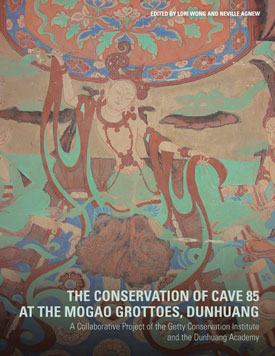
The Conservation of Cave 85 at the Mogao Grottoes, Dunhuang: A Collaborative Project of the Getty Conservation Institute and the Dunhuang Academy
Edited by Lori Wong and Neville Agnew
2014
458 pages
PDF file size: 29.1 MB
Description
The Mogao Grottoes, a World Heritage Site in northwestern China, are located along the ancient caravan routes—collectively known as the Silk Road—that once linked China with the West. Founded by a Buddhist monk in the late fourth century, Mogao flourished over the following millennium, as monks, local rulers, and travelers commissioned hundreds of cave temples cut into a mile-long rock cliff and adorned them with vibrant murals. More than 490 decorated grottoes remain, containing thousands of sculptures and some 45,000 square meters of wall paintings, making Mogao one of the world’s most significant sites of Buddhist art.
In 1997 the Getty Conservation Institute, which had been working with the Dunhuang Academy since 1989, began a case study using the Late–Tang dynasty Cave 85 to develop a methodology that would stabilize the deteriorating wall paintings. This abundantly illustrated volume is the definitive report on the project, which was completed in 2010.
Table of Contents
- Foreword
- Acknowledgements
- Introduction
- Historical Periods of Dunhuang
- Background & Methodology
-
- Background of the Cave 85 Project
-
- The Cave 85 Project
-
- Project Methodology
-
- Information Management
-
- Information Gathering
-
- The Mogao Grottoes
-
- Geology and Geomorphology
-
- Climatic Conditions
-
- Cave 85
-
- Physical and Conservation History
-
- Assessments
-
- Statement of Cultural Values and Significance
-
- Management Context
-
- Condition Assessment
-
- Findings & Implementations
-
- Original Materials and Techniques
-
- Environmental Conditions
-
- Diagnostic Investigation
-
- Salt-Induced Deterioration
-
- Preventative Measures and Treatment
-
- Condition Monitoring
-
- Presentation and Visitation
-
- Concluding Remarks
-
- References
- Appendixes
- Illustration Credits
- About the Editors
About the Authors
Neville Agnew is principal project specialist at the Getty Conservation Institute. He has led the GCI’s work in China since its inception in 1989. A scientist with a PhD in chemistry, he worked previously in academic institutions in Australia and South Africa and has participated in many of the GCI’s projects in different parts of the world. Agnew has received several awards for his contributions to heritage preservation in China, including the Friendship Award of the State Council of the People’s Republic of China in 2000.
Lori Wong is a wall painting conservator and graduate of the Courtauld Institute of Art’s Conservation of Wall Paintings Program. Since 2002 she has worked as a project specialist at the Getty Conservation Institute on projects in China, Egypt, and Morocco, striving to improve the approaches to and strategies for protecting and conserving wall paintings.
Martha Demas is a senior project specialist at the Getty Conservation Institute. She received her master’s degree in historic preservation planning and her PhD in archaeology. In addition to her involvement in the Mosaics In Situ and MOSAIKON projects, she has participated in many of the GCI’s international field projects, including projects in China, Egypt, and Tanzania, and in developing methodologies and guidelines, with a principal focus on conservation and management of archaeological sites.
Po-Ming Lin, a former senior research fellow at the Getty Conservation Institute, is presently a conservation engineer consultant specializing in rock mechanics and geotechnical engineering issues.
The late Shin Maekawa was a senior scientist at the Getty Conservation Institute, where he conducted research on microenvironmental technologies for the conservation of cultural objects and the built environments of heritage buildings. Previously he conducted research on oxygen-free environments for conservation. He held an MS in mechanical engineering and a PhD in conservation science. He was a registered engineer with the State of California.
Francesca Piqué is a former research fellow at the Getty Conservation Institute. She joined the Institute staff in 1996 as conservation specialist, Special Projects.
Stephen Rickerby is a wall painting conservator in private practice and a consulting conservator on a number of Getty Conservation Institute projects. He is also on the Board of Examiners and the Board of Studies for the master’s degree course at the Courtauld Institute’s Conservation of Wall Painting Department.
Michael R. Schilling has worked at the Getty Conservation Institute since 1983, presently holding the position of senior scientist. He has been involved in a number of GCI collaborative projects.
Lisa Shekede works in private practice in the United Kingdom and Malta, and cosupervises the fieldwork programs of the Courtauld Institute master’s degree students. She is also a Getty Conservation Institute consultant on the Cave 85 project at the Mogao Grottoes, Dunhuang, China.
Xudong Wang is director of the Dunhuang Academy, which he joined in 1991. He holds a PhD in cultural heritage conservation from Lanzhou University and wrote his dissertation on the topic “Research into Protective Reinforcement of Cave and Earthen Sites in the Arid Environment of Northwestern China.” His research focuses on the conservation of grottoes and earthen architecture sites, and he has been involved in many conservation projects along the Silk Road in addition to projects in Tibet. Wang was a visiting scholar at the Getty Conservation Institute in 2005.
Wang Wanfu is a botanist. After graduating from the Lanzhou University in 1992, he joined the Dunhuang Academy. Since then, he has been in charge of monitoring and maintenance programs for both synthetic and vegetation windbreak fences.
Press Reviews and Awards
“[The] detailed examination and analysis of every aspect of the project . . . makes it stand out as an exemplar of its type.” —Journal of the Institute of Conservation